

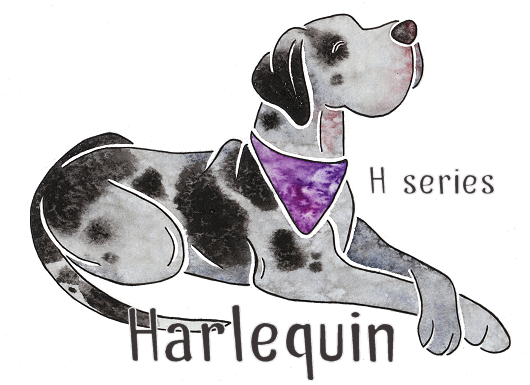
Merle Modifiers
A modifier is a gene that, when inherited along with another gene, will affect the way that a pattern appears. A dog with the modifier but not the gene it modifies will not be affected at all.
One merle modifier has been found so far, and it's found only in one breed (Great Dane).

Already know what you're looking for? Quick Links |
| |
Harlequin
The harlequin modifier (not to be confused with harlequin merle - see Advanced Merle page) turns the areas between the dark patches on a merle into
pure white, sometimes with some grey ticking or patches. This means a blue (black) merle will become white with black patches, because all the grey in its coat is turned to white. What's even more
interesting about this gene is that it also affects phaeomelanin (red), not just eumelanin (black, liver, blue, isabella) like other merle modifiers. That means
that a sable dog with the merling gene won't just be affected on the parts of its coat that are black (tipping, mask etc), but the whole of the coat will be harlequin.
It will become what's known as a "fawnequin" - tan (sable) patches on a white base, with black patches where it would have shown black merling. The patches on the
fawn section of the dog are located where the dog would have had black patches if it had been a solid "blue" (black) merle.
Harlequin occurs on its own locus - H. It is dominant, so H is the harlequin gene and h is the non-harlequin gene. It is inherited separately to merle.
Every single
dog with the harlequin gene AND the merle gene will display harlequin. The only genes that would stop harlequin from being visible would be ones that turn the dog
completely or almost completely white, and these are not present in Great Danes (except for double merle). Any other dog, whether it is brindle, sable, masked, or whatever, will become a harlequin. If it has white markings,
the resulting harlequin pattern will simply lack dark spots where the white markings are supposed to be.
The harlequin gene will not work its own - it requires the merle gene as well. So most harlequins are HhMm (heterozygous for both harlequin and merle). It's thought that harlequin is an embryonic lethal gene, meaning that two copies of it will cause the puppy to be re-absorbed into the womb. This means we can assume that all harlequins are heterozgous for harlequin, and it is certainly true that all harlequins that have undergone
genetic testing so far have been heterozygous. A very lightly marked harlequin (with few dark spots) may be homozygous for merle (MM), which may come with any of the health issues sometimes associated with double merle dogs. A non-harlequin dog, such as a solid black or a black with irish spotting (known as a "mantle" in Great Danes) may carry harlequin
but not display it because they don't have the merle gene. Such a dog would be Hhmm (heterozygous for harlequin, homozygous for non-merle), and if bred to a merle may produce harlequin puppies.
The one colour that a harlequin dog cannot have patches of is merle itself (meaning a patch that is grey with black sections). Dogs that appear to be
harlequin with merle patches (sometimes called "merlikins" or "merlequins") are in fact homozygous merles or piebalds without the harlequin gene. Homozygous merle causes a piebald-like pattern, and the patches may have torn edges and appear very harlequin-like.
"Merlikin" is, therefore, a misleading term.
Quick Summary!
True harlequin (H locus) occurs only in Great Danes, although a similar pattern is sometimes seen in other merle breeds and is due to a variation in the merle gene (known, confusingly, as "harlequin merle", Mh). Harlequin causes the grey background on a merle to be diluted to white, leaving dark patches on a white background, and can affect any type of merle (including brindle, sable etc, as well as double merles). It is a dominant embryonic lethal gene, so all HH dogs are reabsorbed into the womb and only Hh dogs are born. Further Info and Links
The gene causing harlequin in Great Danes is PSMB7, located on chromosome 9. Although this gene has been found, it's still unclear precisely how it interacts with the SILV gene (merle) to cause the loss of the background (dilute) pigment.
Links to studies:
** Please note that I am not a research scientist, and the information on this page comes from my own knowledge and observation of dogs, observational and testing data provided via e-mail by site visitors, any research papers linked on the page, and the information provided by Dr Sheila M. Schmutz on her excellent website http://homepage.usask.ca/~schmutz/dogcolors.html
For further genetics resources, see the Links page

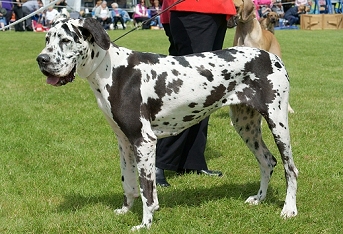
A dog with the harlequin gene but no merle gene will have a normal coat colour. Harlequin can only be displayed if there is a merle gene present.

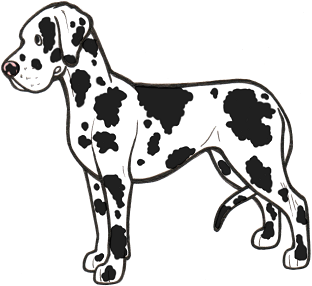
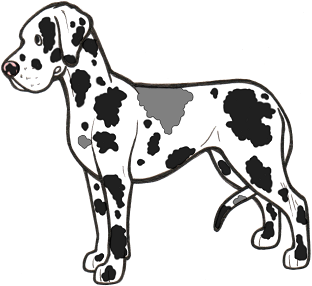
Typical harlequin (HhMm). The second picture shows dilute patches, which can occur on harlequins just as they do on regular merles.
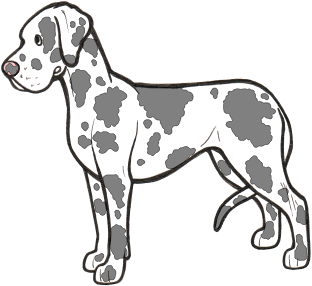
Harlequin with the dilution gene, turning the patches and nose blue (ddHhMm). Dilute harlequins are sometimes known as "porcelains".
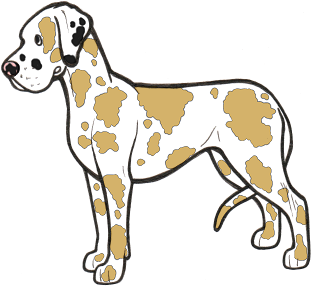
Harlequin with the sable and masking genes (AyAyEmEmHhMm), otherwise known as a fawnequin.
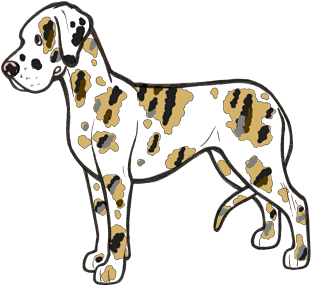
Harlequin with the brindle gene (sable is also necessary for the brindle to show all over the body) (ayaykbrkbrHhMm). The brindle will be broken up and patchy because of
the merle gene (see merle page).
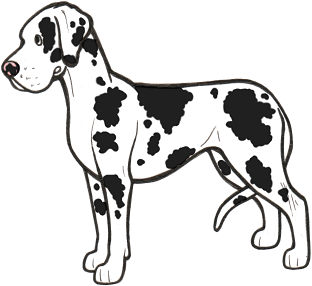
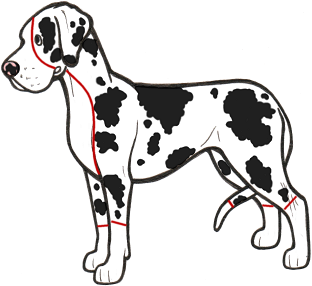
Harlequin with irish spotting (HhMmsisi). The red line shows the border between the harlequin markings and the white spotting. Irish spotting is very common in harlequins as mantle x harlequin is considered a "safe" breeding in Great Danes (one that is unlikely to produce disqualified colours/patterns) and is often recommended by breed clubs.
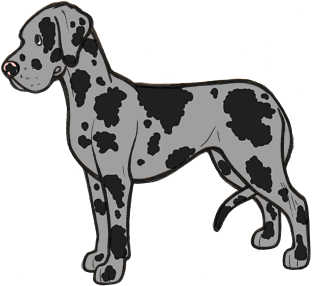
Merle without the harlequin gene (hhMm)
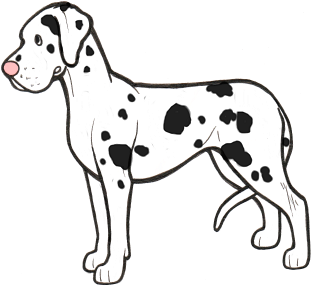
Lightly-marked harlequin, most likely a double merle (HhMM)
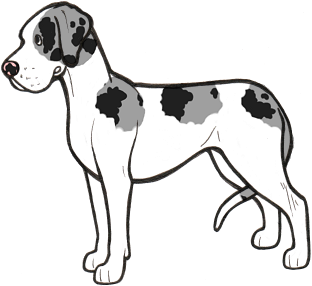
Merlequin pattern. Although this looks similar to a harlequin, it's actually a regular merle with piebald markings (spsp). Note how the patches are confined to the back and aren't a solid colour. The same look can be caused by double merle (MM) also, and this is more likely to be the explanation for this pattern in countries where piebald isn't a recognised Dane pattern (e.g. USA).

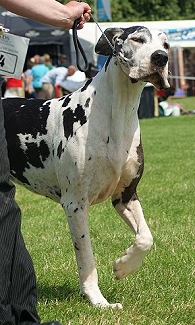

These two pictures show Great Danes with normal black harlequin. The first dog has the irish spotting white pattern (there are no spots on the front of the neck, the lower legs or the face).
Black (blue merle) harlequin is the only type accepted by the Great Dane standard, but the other colours shown in the illustrations above do occur in the breed.
Both of the dogs in the photos also show greyish areas which are reminiscent of the original merle colouration. Dilute patches are common in harlequins, but dogs with jet
black patches and a solid white base (with no grey areas or ticking of any kind) are preferred.
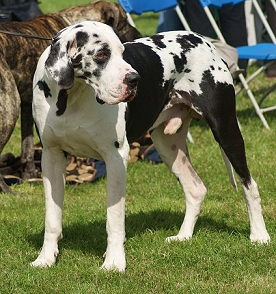
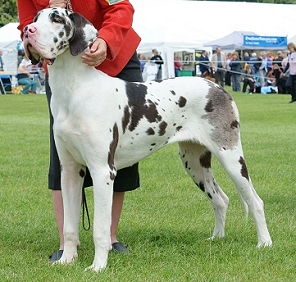
The first harlequin here has very large patches, which are generally not preferred in the breed. The second dog shows a pattern that is currently much more fashionable in the show ring, with smaller, more "torn" patches and a large amount of white.
Note the large dilute patch on the hip and the clear mantle white pattern.
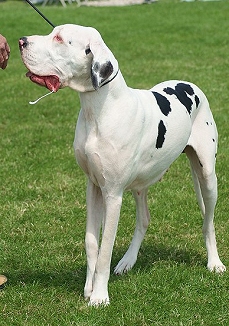
This harlequin is most likely a double merle as well, due to the high amount of white.
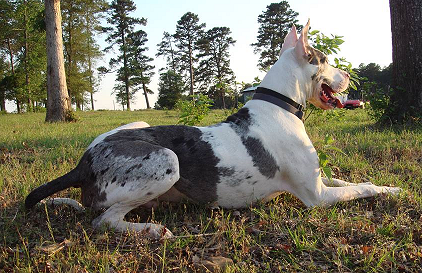
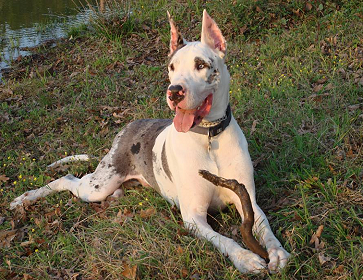
Mauser, the handsome Great Dane above, is an example of a "merlequin", most likely a double merle (MMhh - two copies of merle allele, no copies of harlequin allele). Note how his patches are merled, not solid black like on a harlequin. His pictures were submitted by Jennifer McLean.
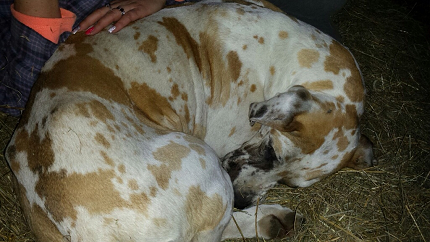
"Fawnequin" (fawn harlequin), submitted by Sally.

No time to read the whole thing? Here's the quick version!

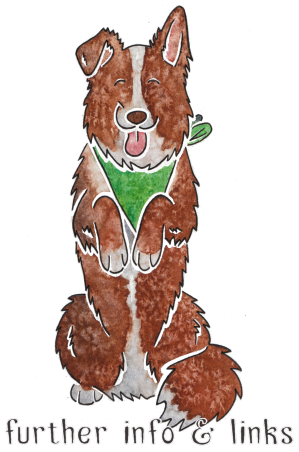
A missense mutation in the 20S proteasome beta 2 subunit of Great Danes having harlequin coat patterning: http://www.sciencedirect.com/science/article/pii/S0888754311000164

